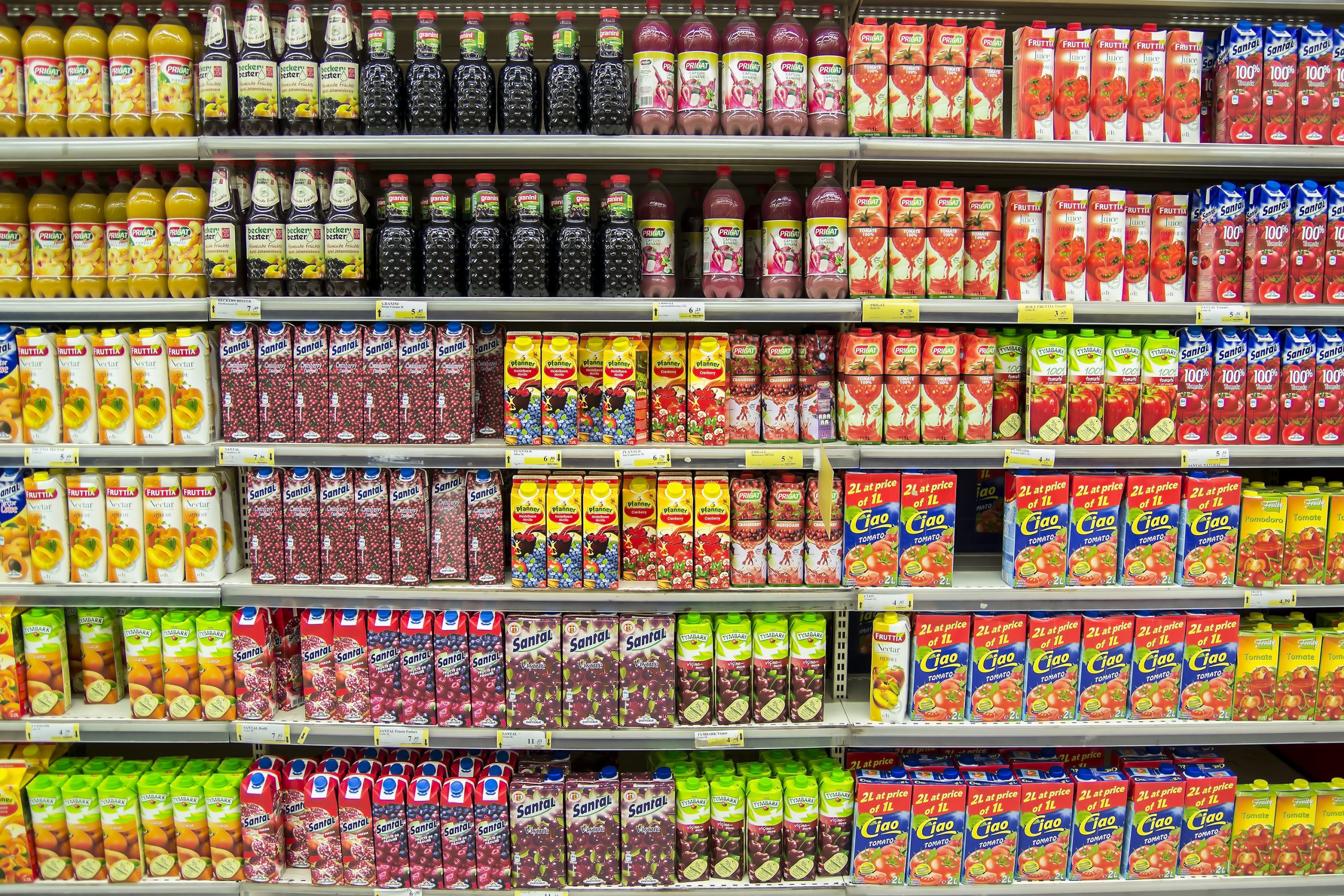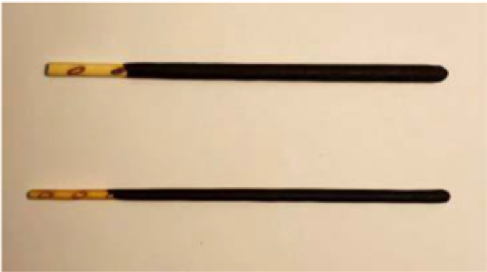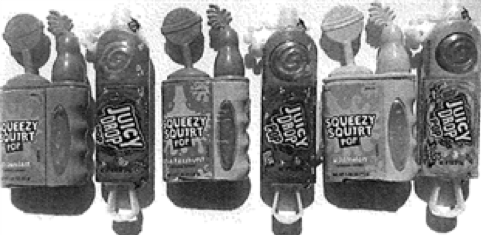“Choosing distinct and unique designs for your product packaging and design may not only attract consumers, but it will also increase your ability to protect your products against infringement.”
 Companies trying to compete for supermarket shelf space and consumer attention frequently turn to packaging and product designs that will stand out. If the product succeeds, one unfortunate side effect for the brand owner is the market can become flooded with “me too” products that attempt to ride on the coattails of that success. How do owners of unique products protect themselves? Trade dress protection is one legal tool that companies should consider.
Companies trying to compete for supermarket shelf space and consumer attention frequently turn to packaging and product designs that will stand out. If the product succeeds, one unfortunate side effect for the brand owner is the market can become flooded with “me too” products that attempt to ride on the coattails of that success. How do owners of unique products protect themselves? Trade dress protection is one legal tool that companies should consider.
Dress it Up
Trade dress is a product’s or packaging’s overall appearance and design, including size, shape, color, color combinations, textures, graphics, and arrangement of those elements. There are two types of trade dress, and the distinction is important: product-packaging and product-design. Product-packaging consists of the overall combination and arrangement of design elements, including graphics, layout, color, and/or color combinations. Product-design is the product shape, configuration, or design features. The Supreme Court, in Wal-Mart Stores, Inc. v. Samara Bros., distinguished the two by holding that product-packaging can be inherently distinctive, meaning that no secondary meaning is required to be entitled to protect such trade dress; product-design, on the other hand, can never be inherently distinctive and secondary meaning must always be shown. 529 U.S. 205 (2000). To succeed in a trade dress infringement case, plaintiffs must show (1) that the asserted trade dress is non-functional; (2) that it is inherently distinctive or has acquired distinctiveness; and (3) a likelihood of confusion.
Functionality
A product feature is “functional” if it is essential to the use or purpose of the article, or if it affects the cost or quality of the article such that the exclusive use of the feature would put competitors at a significant, non-reputation-related disadvantage. For product designs, it is critical to consider whether any utility patents have been obtained for the trade dress. The Supreme Court held that a utility patent that identifies utilitarian advantages is “strong evidence” that the design is functional. TrafFix Devices, Inc. v. Mktg. Displays, Inc., 532 U.S. 23, 29 (2001). While functionality is frequently a concern for product-design trade dress, product-packaging trade dress is typically non-functional because it does not provide utilitarian advantages to the consumer and does not affect the actual benefit that consumers seek to purchase. See, e.g., Fiji Water Co. v. Fiji Mineral Water U.S. LLC, 741 F. Supp. 2d 1165, 1176 (C.D. Cal. 2010) (finding bottled water trade dress to be non-functional).
Distinctiveness
Regarding distinctiveness, product-packaging trade dress can be inherently distinctive. The Federal Circuit provides a four-factor test in assessing whether product-packaging trade dress is inherently distinctive: 1. if the design is a common basic shape or design; 2. if it is unique or unusual in a particular field; 3. If it is a mere refinement of a commonly-adopted and well-known form of ornamentation for a particular class of goods viewed by the public as a dress or ornamentation for the goods; and 4. if it is capable of creating a commercial impression distinct from any accompanying words. In re Chippendales USA, Inc., 622 F.3d 1346, 1352 (Fed. Cir. 2010).
For product-packaging that is not inherently distinctive and product-design trade dress, a plaintiff must demonstrate that the trade dress has acquired distinctiveness. Typical evidence that courts will consider include: (1) Advertising expenditures; (2) Sales success; (3) Length and exclusivity of use; (4) Unsolicited media coverage; (5) Industry recognition or awards; (6) “Look-for” advertising; (7) Defendant’s intentional copying; and (8) Surveys demonstrating consumer recognition of the claimed trade dress.
A federal trademark registration is prima facie evidence of the validity of, ownership of, and exclusive right to use the registered trade dress. Courts have found that a federal registration shifts the burden of proof on the first two elements (non-functionality and validity of the trade dress) to defendants. Au-Tomotive Gold v. Volkswagen of Am., 457 F.3d 1062, 1072 (9th Cir. 2006).
Likelihood of Confusion
Turning to the third element, a plaintiff must establish a likelihood of confusion as to the source or origin of or an affiliation between plaintiff’s and defendant’s products. Each circuit has a multifactor test that typically tracks the circuit’s likelihood of confusion factors. There are a few common considerations concerning likelihood of confusion that arise in trade dress cases.
First, courts consider the overall appearance and commercial impression of parties’ respective trade dress. McNeil Nutritionals, LLC v. Heartland Sweeteners, LLC, 511 F.3d 350 (3d Cir. 2007).
Second, courts are often asked to consider the effect of distinctive house marks. Typically, courts recognize that the presence of a house mark can decrease, but not on its own dispel, the likelihood of confusion. Id. (presence of store brand’s mark and combined with differences in the trade dress sufficient to dispel confusion in some, but not all products before the court). This is particularly true when the marks involved are recognizable popular brands. That said, the question of trade dress confusion is not a “reading test,” and the presence of house brands is not itself dispositive. Two Pesos, Inc. v. Taco Cabana, Inc., 932 F.2d 1113 (5th Cir. 1991); see also Maker’s Mark Distillery, Inc. v. Diageo North America, Inc., 679 F.3d 410, 422 (6th Cir. 2012) (prominent use of well-known Jose Cuervo house mark not sufficient to avoid confusion with Maker’s Mark’s dripping red wax trade dress).
Third, purposeful copying often plays a critical role in trade dress cases. Courts are particularly concerned when a design is selected with knowledge of the senior user, intent to copy distinctive elements, and when the product is intended to appear next to competitive products in stores. See, e.g., Spangler Candy Co. v. Tootsie Roll Indus., LLC, 372 F. Supp. 3d 588, 606-607 (N.D. Ohio 2019). Intent can be inferred depending on the context of the copying.
Recent Examples
This summer, three trade dress infringement actions illustrated these various principles.
In Ezaki Glico Kabushiki Kaisha v. Lotte Int’l Am. Corp, No. 19-3010 (3d Cir. July 9, 2020), the Court of Appeals determined that the product configuration of the registered, incontestable trade dress for Pocky’s cookies was functional and therefore non protectable. The court cited the plaintiff’s own marketing describing utilitarian advantages of the shape as evidence that confirms the Pocky’s design is functional.

In Topps Co., Inc. v. Koko’s Confectionery & Novelty, 16 Civ. 5954 * 15 (S.D.N.Y. Aug. 27, 2020), the court concluded that the trade dress for Juicy Drop Pop and Squeezy Squirt Pop were not confusingly similar because “the nozzle cap and candy handle are adjacent to each other, while the nozzle and the handle in JDP are located on opposite ends. SSP’s nozzle cap has a plastic ‘geyser’ of the liquid candy in the same color as the nozzle cap, whereas JDP lacks an analogous feature and its nozzle and nozzle cap are a different color from that of the rest of the trade dress. SSP’s nozzle cap and handle are far larger and in different shapes from those of JDP. Lastly, SSP’s bottle has an oval-shaped compressible portion with concentric ovals; JDP ‘s compressible bottle has a round compressible portion with a swirl design.”

In Vital Pharms., Inc. v. Monster Energy Co., CASE NO. 19-60809-CIV (July 7, 2020 S.D. Fla.), the court considered whether Monster Energy’s new REIGN packaging trade dress infringed on the Bang trade dress.


The court rejected Monster’s motion for summary judgment on the ground that the BANG packaging was not inherently distinctive or that it lacked secondary meaning, finding that those were issues of fact. As one example, the court found that evidence in the record could be interpreted as circumstantial evidence of intentional copying, which would help to establish secondary meaning.
Takeaways
Ultimately, brands should consider three key points when it comes to trade dress:
(1) Choosing distinct and unique designs for your product packaging and design may not only attract consumers, but it will also increase your ability to protect your products against infringement.
(2) The intentional copying of another’s distinct and unique designs puts your company at risk, and the use of a house mark may not be sufficient to avoid liability.
(3) Registering and litigating trade dress are fact intensive endeavors. To navigate successfully the various considerations in protecting your trade dress, involving counsel at an early stage is important to set marketing and registration strategies that can best position your trade dress should enforcement become necessary.
Top image source: Deposit Photos
Photography ID:22213327
Copyright:radub85
Other images taken from linked decisions.

![[IPWatchdog Logo]](https://ipwatchdog.com/wp-content/themes/IPWatchdog%20-%202023/assets/images/temp/logo-small@2x.png)

![[[Advertisement]]](https://ipwatchdog.com/wp-content/uploads/2024/04/Patent-Litigation-Masters-2024-banner-early-bird-ends-Apr-21-last-chance-938x313-1.jpeg)
![[Advertisement]](https://ipwatchdog.com/wp-content/uploads/2024/04/Patent-Litigation-Masters-2024-sidebar-early-bird-ends-Apr-21-last-chance-700x500-1.jpg)

![[Advertisement]](https://ipwatchdog.com/wp-content/uploads/2021/12/WEBINAR-336-x-280-px.png)
![[Advertisement]](https://ipwatchdog.com/wp-content/uploads/2021/12/2021-Patent-Practice-on-Demand-recorded-Feb-2021-336-x-280.jpg)
![[Advertisement]](https://ipwatchdog.com/wp-content/uploads/2021/12/Ad-4-The-Invent-Patent-System™.png)







Join the Discussion
One comment so far.
Ernesto Leckie
December 19, 2020 08:48 amI’m very happy to read this. This is the kind of details that needs to be given and not the random misinformation that’s at the other blogs. Appreciate your sharing this best doc.